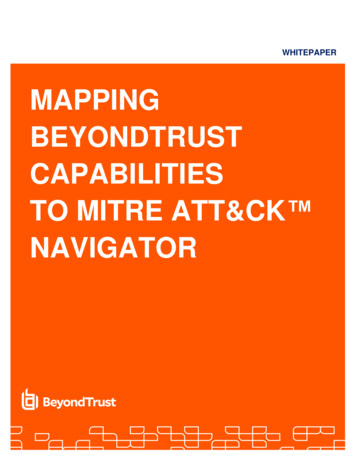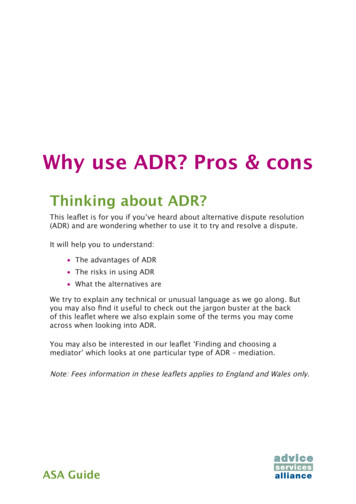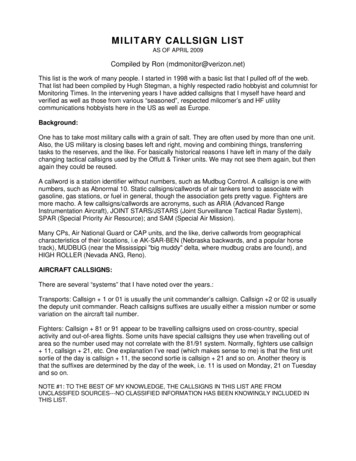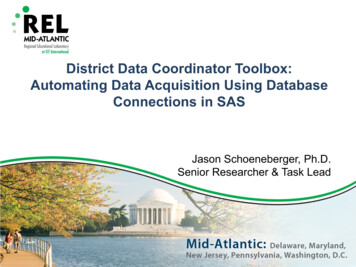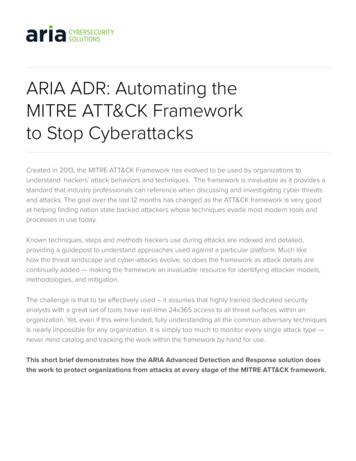
Transcription
ARIA ADR: Automating theMITRE ATT&CK Frameworkto Stop CyberattacksCreated in 2013, the MITRE ATT&CK Framework has evolved to be used by organizations tounderstand hackers’ attack behaviors and techniques. The framework is invaluable as it provides astandard that industry professionals can reference when discussing and investigating cyber threatsand attacks. The goal over the last 12 months has changed as the ATT&CK framework is very goodat helping finding nation state backed attackers whose techniques evade most modern tools andprocesses in use today.Known techniques, steps and methods hackers use during attacks are indexed and detailed,providing a guidepost to understand approaches used against a particular platform. Much likehow the threat landscape and cyber-attacks evolve, so does the framework as attack details arecontinually added — making the framework an invaluable resource for identifying attacker models,methodologies, and mitigation.The challenge is that to be effectively used – it assumes that highly trained dedicated securityanalysts with a great set of tools have real-time 24x365 access to all threat surfaces within anorganization. Yet, even if this were funded, fully understanding all the common adversary techniquesis nearly impossible for any organization. It is simply too much to monitor every single attack type —never mind catalog and tracking the work within the framework by hand for use.This short brief demonstrates how the ARIA Advanced Detection and Response solution doesthe work to protect organizations from attacks at every stage of the MITRE ATT&CK framework.
Mitre Att&ck EnterpriseRECON WEAPONIZE DELIVER EXPLOIT C&C EXECUTE MAINTAINRESOURCE DEVELOPMENTCREDENTIAL ACCESSEXFILTRATIONADR can detect and identifyall networked devices. Detectscompromised accountsand infrastructure.The adversary is trying to stealaccount names and passwordsThe adversary is tryingto steal dataADR monitors credential use andaccess at the directories and atthe applications. It can detect oddcredential use behaviors leveragingML, including what when, fromwhere, how often and simultaneoususe to name but a few vectors.ADR can detect exfiltrations ofdata from Servers, VMs, containersand end points. In conjunctionit can detect egress attemptsacross a large number of potentialexit points including: the internalnetwork, the Cloud USB interfaces,and even through the firewallsuch as via monitoring traffic overports that must be left openINITIAL ACCESSThe adversary is trying toget into your networkADR monitors all paths ofaccess into the organization’senvironment: Through theFirewall, Over the Network,From the End point.EXECUTIONThe adversary is tryingto run malicious codeADR can detect execution ofprocesses on monitored end points.DISCOVERYThe adversary is trying tofigure out your environmentADR discovers all internal networkconnected assets, and allows forthe classification of such assets sotthey can be properly monitoredand upfront protected with strongnetwork connectivity polices.LATERAL MOVEMENTPERSISTENCEThe adversary is trying tomaintain their footholdADR watches for threat behaviorsover days and weeks,detectingand correlating threatbehaviors exhibited by APTs/intrusions and other attacks.PRIVILEGE ESCALATIONThe adversary is trying to gainhigher-level permissionsADR monitors the Directoriesfor privilege use and escalation,critical to detecting bothcompromised credentials andmalicious insider types of misuse.The adversary is trying to movethrough your environmentADR’s superior approach tonetwork monitoring detectsall forms of lateral movement.Applying ML detects behaviorsthat are odd for devices or typesof devices. Attack behaviorsassociated with intrusions andthreat spreads are alreadyknown to the system and can bepicked up as they go active.COMMAND AND CONTROLThe adversary is trying tocommunicate with compromisedsystems to control themADR was built to detect attemptsto connect to external CnC. Itdetects CnC outreach behaviorsuch as from TCP floods andbeaconing. It adds to this theindustry’s most comprehensiveThreat Intelligence feed that isupdated daily with millions ofknown bad and cleaned up CnCsites. It can detect attempts - andstop them before connectivity tothem is attained.IMPACTThe adversary is trying tomanipulate, interrupt, or destroyyour systems and dataADR detects accounts accessedand removed. It detects datamanipulation destruction andremoval. Detects internalnetwork as well device basedDoS attacks. Detects resourcecompromise/hijacking.
A RIA A D R : AU TOM AT IN G T H E M IT R E AT T& C K FRAME WO RKari acybersecurit y.com 3Let’s look at an example of ARIA ADR at work. This system was deployed in an energy and utility provider.Cybersecurity had been outsourced to their MSP, but that approach had failed a required penetration test andsecurity audit. ADR was put in to help the utility’s IT staff to get a better hold on what was happening to ensurecompliance with industry requirements. ADR ingested output from the utility’s infrastructure including theirfirewalls, directories, as well as events from critical applications and from cloud services. Also included wereevents from Windows and Linux servers as well as from employee devices. Lastly network flow analytics werealso ingested from the internal network and the firewalls. The goal is a wide and all-encompassing MAP ofcoverage as per the frameworks prescribed best practices.What happened next was telling. After a month in place a simple concise alert appeared in the system UIindicating a verified intrusion into the utility had begun, detailing the devices involved. How was this found?The detail is shown by looking at ADR’s rendering of the alerts threat behaviors found that corresponded tothe ATT&CK framework.As shown in the figure above, ADR at this stage of the attack (when captured off the UI) had seen overtime 14 different behaviors as identified by the ATT&CK Framework. What this means is that as an attackprogresses through its kill chain, it begins to exhibit more instances of a given behavior as well as additionalbehaviors. ADR maps these behaviors into 72 known attack types. Meaning it uses AI to associate thecombination of behaviors into an alert and continues to confirm this alert with additional threat behavioraldata added over time.The key point is that this effort was all done by ADR. There was no human involvement in identifying thebehaviors, correlating them into an attack, and then providing a validated and a persistent alert that wasshown at the UI level which continued to have additional threat behavior added to it.ADR allowed the IT team, via the same UI alert screen, to stop the attack activity with a single click. Thisaction told the inline deployed ADR device to stop (block) all associated attack communication.
A RIA A D R : AU TOM AT IN G T H E M IT R E AT T& C K FRAME WO RKari acybersecurit y.com 4It will also stop the attackers from communicating in or sending data out through the firewall, and it candisable compromised or escalated credentials if used, to stop access to critical applications and services.After the attack the utility chose to enable the full automation option to automatically stop such attacksinvolving critical systems as detected and verified by ADR.ADR also uses attack behavior-based threat models to pick up polymorphic malware and ransomware. Suchattacks can’t be picked up by AV or IDS signatures as the signatures change with each device compromise.In addition, counting on detecting communication back to known bad sites won’t work as many of theseattacks are programed to change site access continuously making it a battle to keep up. Behavioralapproaches work best. And yet most behavioral based EDRs look for a set pattern of behaviors, and don’thave the ability to employ the more flexible ATT&CK framework approach. Even the best like CrowdStrikecan miss such attacks until they have seen the pattern in the wild and added it to an update. ADR does notcount on seeing a fixed pattern of behaviors with its AI driven approach – allowing it to use the ATT&CKframework to sense any combinations of behavior patterns.Below is such an example. In this case the ADR detected early-stage zero-day ransomware before it gotfurther than the initial systems compromise. Note this zero-day version never used a C&C in the early stagethat most systems rely on to identify the threats.The customer was able to quarantine the device using ADR to prevent further spread, until the device couldbe cleaned and restored. The result was that the attack was stopped in the early phase where, through itsprograming, was attempting to laterally spread internally off the initially compromised device. ADR in thiscase contained what could have been a widespread disaster to a single device.
ARIA ADR was designed to automatically find and stop network-borne threats as soon as they becomeactive, and most importantly, before significant harm occurs. The simple to deploy solution provides builtin AI-driven SOC functions that provide all the benefits of a traditional security operations center (SOC) butoperates without humans, doing so 1000 times faster at a fraction of the comparable cost. Unlike othersolutions, ARIA ADR provides full MITRE ATTACK Framework threat-surface coverage — on premises, datacenters, remote devices, and the Cloud. Operated anywhere by IT resources with no cybersecurity training.ARIA ADR was purpose-built to overcome the critical challenges caused by today’s threat detection andresponse processes and tools. ARIA ADR: Finds, stops the attacks that do the most harm – in near real timebefore significant damage is done. Does all the work of highly skilled analysts, around the clock, andat the speed of electrons – so companies don’t have to pay forthese types of staff and still get much better outcomes. Can be deployed across any environment – on-premises, Cloud,and operated by a remote workforce. Can run fully automated. Allows part-time IT/security staff to use the tool effectively – onlyspending a few minutes a day by getting notified when action needs to be taken. Provides all the forensic detail required when an attack does happen Ensures compliance. Lowers cyber insurance qualification and premiums by meeting new strict criteriaContact Us at ARIAsales@ariacybersecurity.com to Schedulea Technical Demonstration or Arrange an EvaluationABOUT ARIA CYBERSECURITY SOLUTIONSARIA Cybersecurity Solutions recognizes that better, stronger, more effective cybersecurity starts with a smarter approach. Oursolutions provide new ways to monitor all internal network traffic, while capturing and feeding the right data to existing security toolsto improve threat detection and surgically disrupt intrusions. Customers in a range of industries rely on our solutions each and everyday to accelerate incident response, automate breach detection, and protect their most critical assets and applications. With a proven track record supporting the Department of Defense and many intelligence agencies in their war on terror, and an award-winningportfolio of security solutions, ARIA Cybersecurity Solutions is committed to leading the way in cybersecurity success.ARIA Cybersecurity Solutions 175 Cabot St, Suite 210 Lowell, MA O1854Connect with Us: ariacybersecurity.com ARIAsales@ariacybersecurity.com 800.325.3110Follow Us: Linkedin Facebook Twitter BlogREV1.0-WP-12 21-ARIA ADR MITRE
also ingested from the internal network and the firewalls. The goal is a wide and all-encompassing MAP of coverage as per the frameworks prescribed best practices. What happened next was telling. After a month in place a simple concise alert appeared in the system UI . solutions provide new ways to monitor all internal network traffic, while .



